Hearty Polish Pasta Casserole Recipe: A Comforting Family Gem
Nestled in culinary traditions, polish pasta casserole brings comfort straight to your dinner table with hearty, soul-warming ingredients.
Generations of home cooks have perfected this delightful dish through careful techniques passed down between kitchens.
Creamy textures and rich flavors blend seamlessly in this simple yet sophisticated meal.
Cheese and noodles create a magical combination that satisfies deep hunger pangs.
Crispy edges and soft centers make each bite a delectable experience worth savoring.
Potatoes, bacon, and tender pasta merge into a symphony of taste that feels like a warm embrace.
Polish Pasta Casserole Overview
Ingredients for Polish Pasta Casserole
Pasta Base:Protein and Savory Ingredients:Dairy and Sauce Components:Seasoning and Flavor Enhancers:Cooking Auxiliaries:How to Prepare Polish Pasta Casserole
Step 1: Warm Up the Oven
Set your oven to 350°F (177°C) so it’s ready for baking the delicious casserole.
Step 2: Prepare the Baking Dish
Coat a 9×13-inch baking dish with butter or nonstick cooking spray to ensure nothing sticks.
Step 3: Cook the Pasta
Boil water in a large pot, add salt, and cook pasta until it reaches al dente perfection. Drain and transfer to a large mixing bowl.
Step 4: Create the Creamy Sauce
Melt butter in a saucepan over medium heat. Whisk in flour and cook for one minute, stirring constantly to prevent burning.
Gradually pour in milk, whisking until the sauce becomes smooth and thick.
Step 5: Season the Sauce
Remove from heat and stir in:Step 6: Combine Ingredients
Mix the pasta with the creamy sauce and add:Stir until everything is well combined.
Step 7: Assemble the Casserole
Transfer the mixture to the prepared baking dish. Spread evenly and sprinkle the remaining one cup of Swiss cheese on top.
Step 8: Bake to Golden Perfection
Bake in the preheated oven for 30-40 minutes until the top turns golden brown and the casserole is bubbling with deliciousness.
Step 9: Rest and Serve
Remove from the oven and let it rest for five minutes.
This allows the flavors to mingle and the cheese to set slightly before serving.
Expert Tips for Polish Pasta Casserole
Variations on Polish Pasta Casserole
Pairing Suggestions for Polish Pasta Casserole
Storage Tips for Polish Pasta Casserole
FAQs
This dish is a traditional Polish comfort food known as a hearty one-pot meal that combines classic Polish ingredients like sauerkraut and sausage with pasta and cheese.
Yes, you can substitute Swiss cheese with other melting cheeses like Gouda, Emmental, or even mild cheddar to achieve a similar creamy texture and flavor profile.
No, this recipe contains sausage and is not vegetarian-friendly. To make it vegetarian, you would need to replace the sausage with a plant-based alternative or additional vegetables.
Print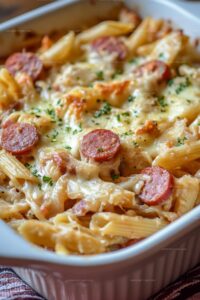
Polish Pasta Casserole Recipe
- Total Time: 1 hour 10 minutes
- Yield: 8 1x
Description
Hearty Polish pasta casserole brings together comforting noodles, creamy cheese, and savory bacon in a classic dish from Eastern European cuisine. Polish home cooks cherish this satisfying meal that connects you to traditional family recipes.
Ingredients
- 1.5 lb smoked Polish sausage or kielbasa (cut into 1/2-inch slices)
- 4 cups uncooked short pasta (penne or fusilli recommended)
- 3 cups grated Swiss cheese (divided)
- 2.5 cups milk
- 1 cup sour cream
- 1 jar 16 oz sauerkraut (thoroughly rinsed and well-drained)
- 4 green onions (finely chopped)
- 2 tbsps unsalted butter
- 2 tbsps all-purpose flour
- 2 tbsps Dijon mustard
- 1 tsp garlic powder
- Kosher salt (to taste)
- Freshly ground black pepper (to taste)
Instructions
- Heat oven to 350°F (177°C), ensuring proper temperature for even cooking.
- Coat a 9×13-inch baking dish with butter or nonstick spray to prevent adhesion.
- Boil salted water in a large pot for pasta preparation.
- Cook pasta until perfectly al dente, following package instructions precisely.
- Drain pasta thoroughly and transfer to a spacious mixing bowl.
- Melt butter in a saucepan over medium heat, creating a smooth base for the sauce.
- Incorporate flour into melted butter, whisking continuously for one minute to eliminate raw flour taste.
- Slowly pour milk into the roux, whisking constantly until sauce reaches a creamy, thick consistency.
- Remove sauce from heat and blend in garlic powder, Dijon mustard, and sour cream for enhanced flavor profile.
- Season sauce with kosher salt and freshly ground black pepper to taste.
- Combine pasta with prepared sauce, sauerkraut, sliced sausage, green onions, and two cups of Swiss cheese, mixing thoroughly.
- Distribute pasta mixture evenly in the prepared baking dish, ensuring uniform coverage.
- Sprinkle remaining Swiss cheese across the top, creating a golden, melty surface.
- Bake for 30-40 minutes until cheese turns golden brown and casserole becomes bubbly.
- Allow casserole to rest for five minutes after removing from oven, enabling flavors to integrate and cheese to slightly set.
Notes
- Swap sauerkraut with fresh cabbage for a milder flavor profile that kids might enjoy more.
- Use gluten-free flour and pasta to make this dish completely gluten-free without compromising taste.
- Experiment with different sausage varieties like smoked kielbasa or spicy chorizo to create unique flavor variations.
- Add extra crunch by sprinkling breadcrumbs or crushed crackers on top before baking for a crispy golden texture.
- Prep Time: 30 minutes
- Cook Time: 40 minutes
- Category: Lunch, Dinner
- Method: Baking
- Cuisine: Polish
Nutrition
- Serving Size: 8
- Calories: 511 kcal
- Sugar: 3 g
- Sodium: 850 mg
- Fat: 32 g
- Saturated Fat: 16 g
- Unsaturated Fat: 14 g
- Trans Fat: 0.5 g
- Carbohydrates: 34 g
- Fiber: 2 g
- Protein: 25 g
- Cholesterol: 80 mg

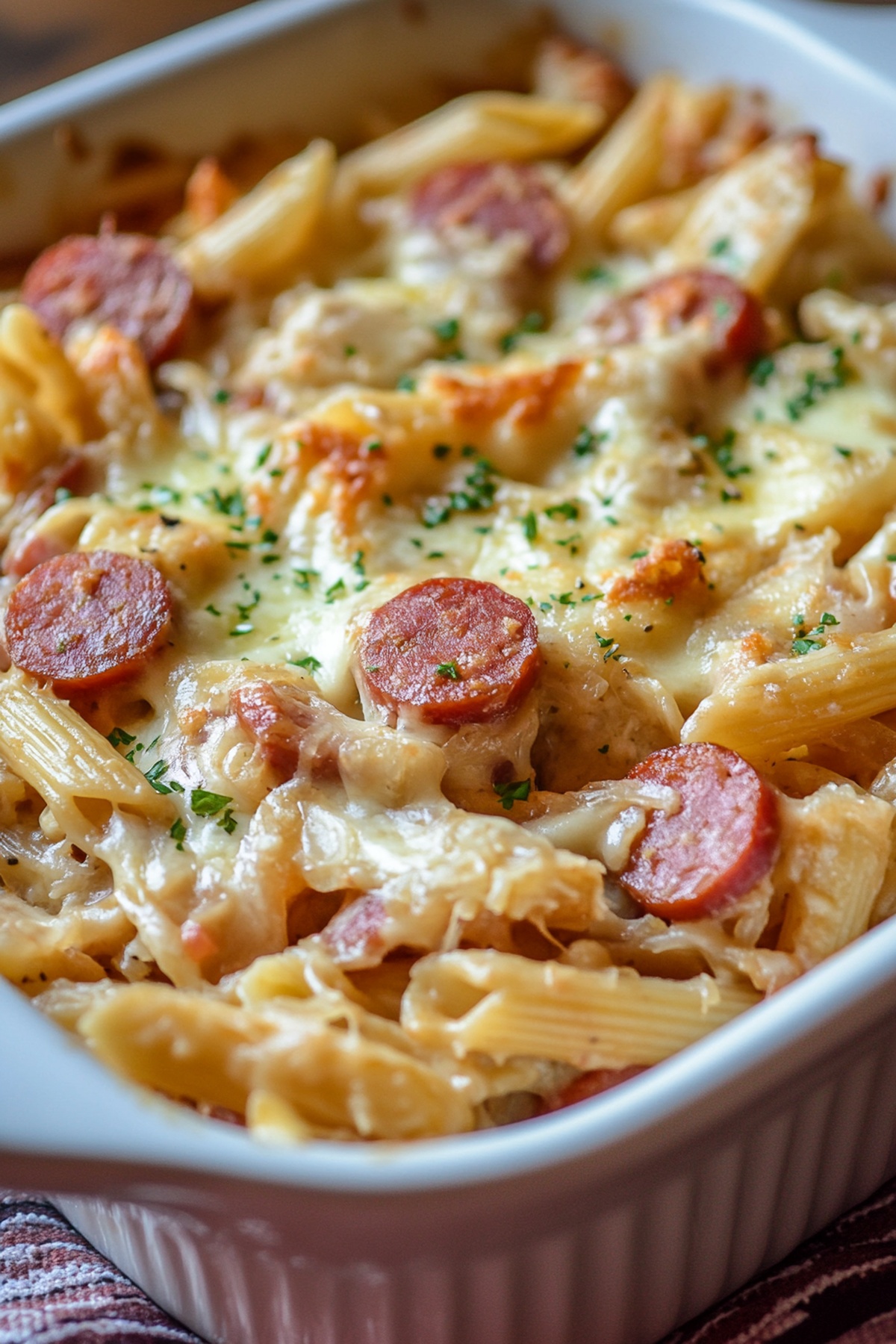

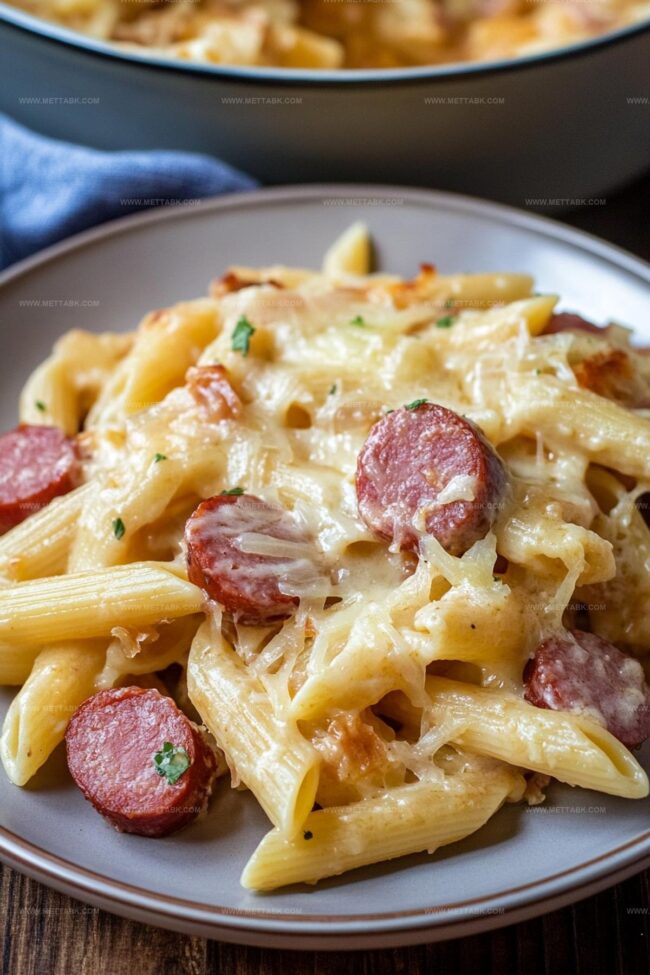
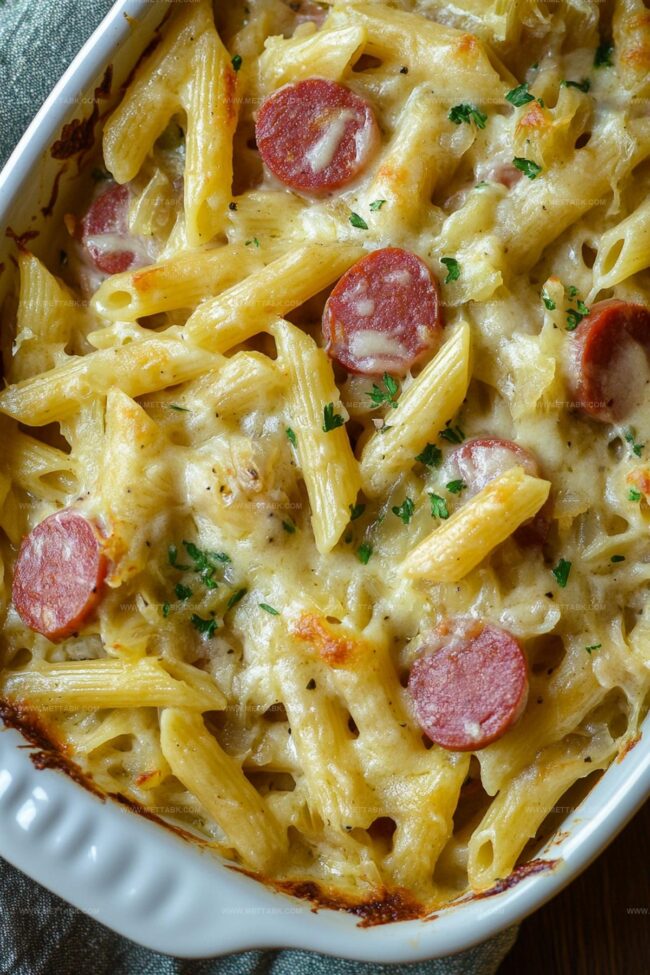
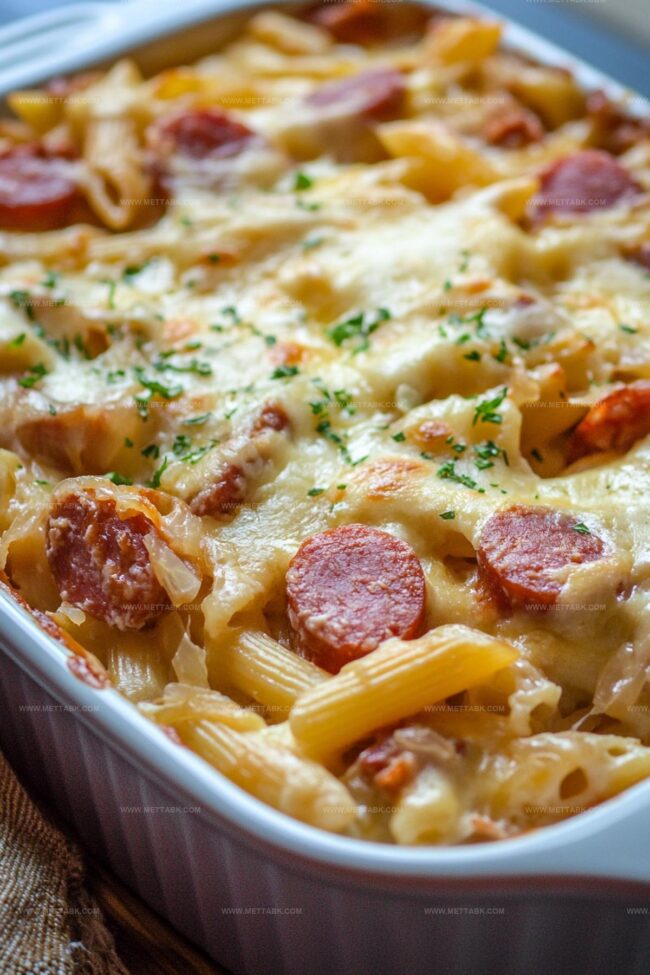
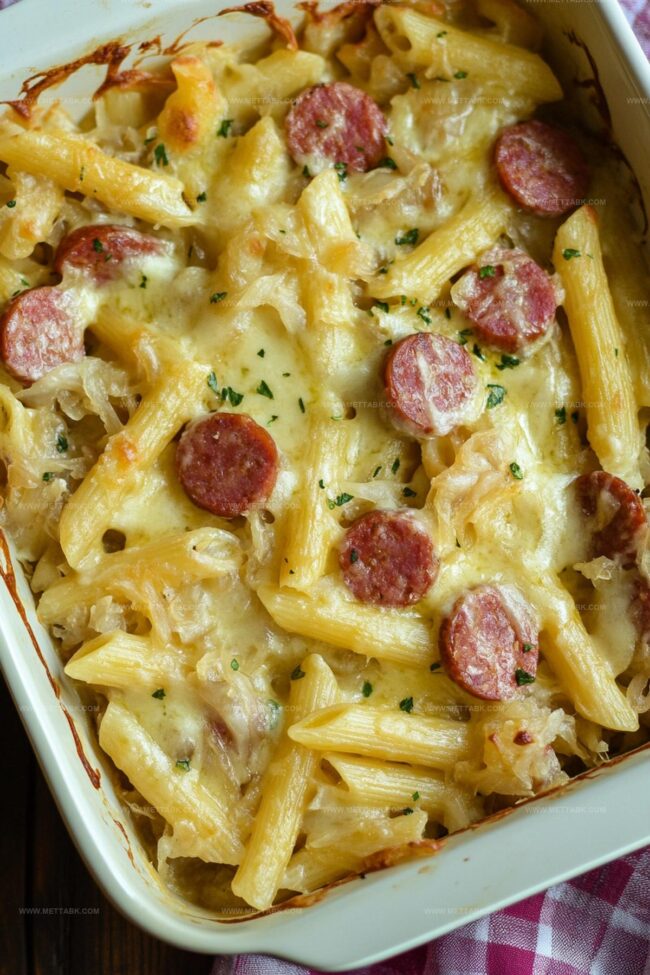
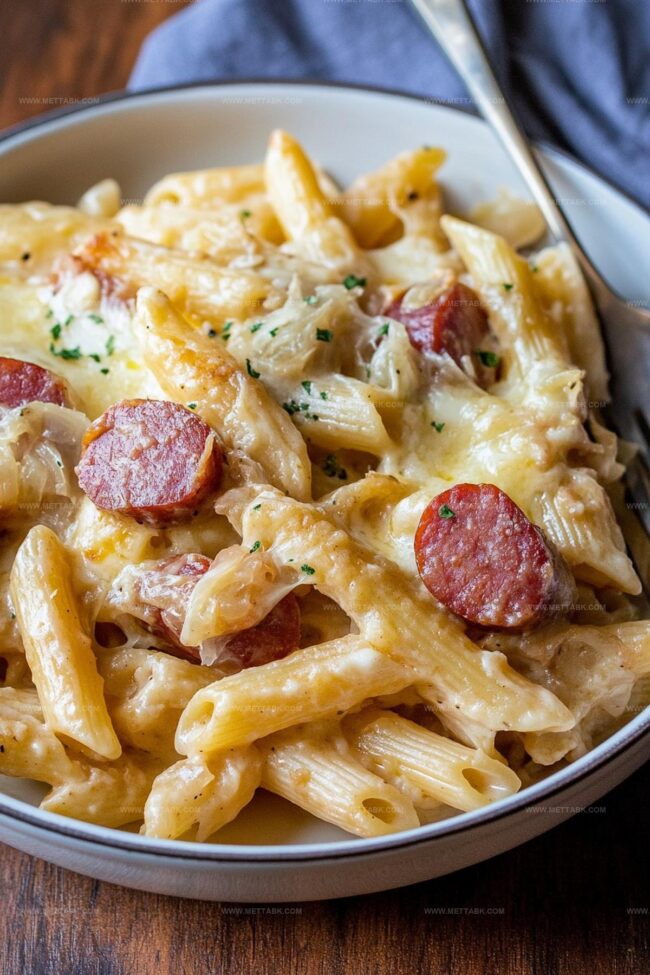
Clara Bennett
Contributing Recipe Developer & Food Writer
Expertise
Baking and Pastry Development, Gluten-Free and Allergy-Friendly Recipe Creation, Culinary Storytelling and Food Journalism, Recipe Testing and Standardization, Southern Comfort Foods and Modern Twists
Education
Sullivan University – National Center for Hospitality Studies
Associate Degree in Culinary Arts
Focus: Baking and Pastry Arts, Recipe Testing, and Culinary Journalism.
Clara specialized in crafting desserts that blend classic Southern comfort with modern techniques, while developing strong writing skills to tell the story behind every dish.
Lane Community College (Certificate Program)
Certificate in Food Writing and Photography
Focus: Culinary storytelling, recipe formatting, food styling, and visual presentation.
Clara’s love of baking started young, powered by homemade pies, biscuits, and stories passed around the family table.
After earning her degree at Sullivan University and a food writing certificate at Lane Community College, she turned her passion into a craft: sharing recipes that are simple, soulful, and always full of heart.
She’s big on bold flavors, flexible ideas, and creating sweets that fit any table (yes, even if you’re gluten-free). When she’s not baking, you’ll find her wandering farmers’ markets, styling food for the next photo shoot, or working on her ever-growing recipe journal.